Jet production in high Q^2 deep-inelastic eo scattering at HERA
- 格式:pdf
- 大小:606.32 KB
- 文档页数:26
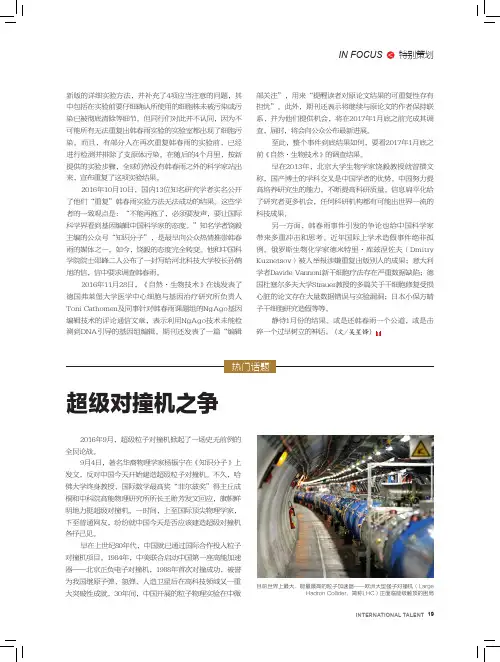
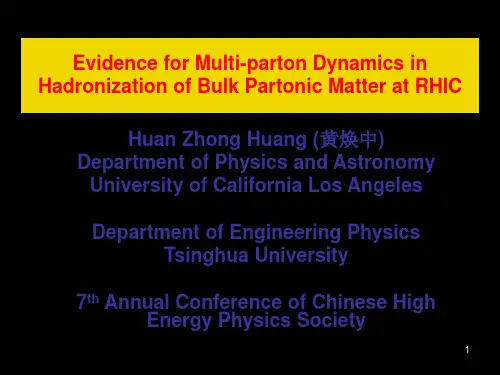
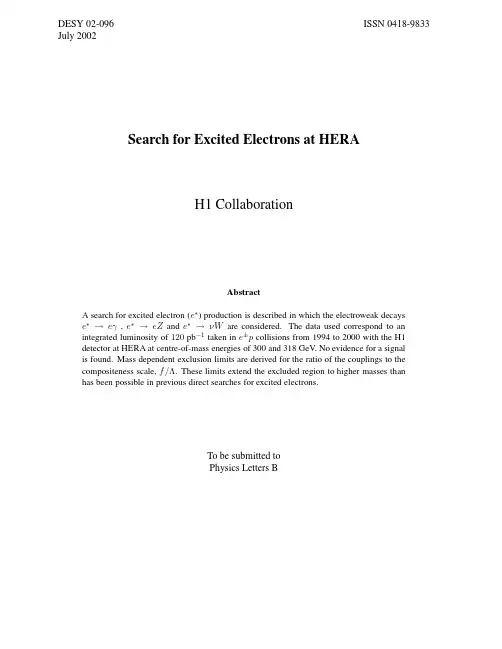
DESY02-096ISSN0418-9833 July2002Search for Excited Electrons at HERAH1CollaborationAbstractA search for excited electron(e∗)production is described in which the electroweak decayse∗→eγ,e∗→eZ and e∗→νW are considered.The data used correspond to anintegrated luminosity of120pb−1taken in e±p collisions from1994to2000with the H1detector at HERA at centre-of-mass energies of300and318GeV.No evidence for a signalis found.Mass dependent exclusion limits are derived for the ratio of the couplings to thecompositeness scale,f/Λ.These limits extend the excluded region to higher masses thanhas been possible in previous direct searches for excited electrons.To be submitted toPhysics Letters BC.Adloff33,V.Andreev24,B.Andrieu27,T.Anthonis4,A.Astvatsatourov35,A.Babaev23,J.B¨a hr35,P.Baranov24,E.Barrelet28,W.Bartel10,S.Baumgartner36,J.Becker37,M.Beckingham21,A.Beglarian34,O.Behnke13,A.Belousov24,Ch.Berger1,T.Berndt14,ot26,J.B¨o hme10,V.Boudry27,W.Braunschweig1,V.Brisson26,H.-B.Br¨o ker2,D.P.Brown10,D.Bruncko16,F.W.B¨u sser11,A.Bunyatyan12,34,A.Burrage18,G.Buschhorn25, L.Bystritskaya23,A.J.Campbell10,S.Caron1,F.Cassol-Brunner22,D.Clarke5,C.Collard4, J.G.Contreras7,41,Y.R.Coppens3,J.A.Coughlan5,M.-C.Cousinou22,B.E.Cox21,G.Cozzika9,J.Cvach29,J.B.Dainton18,W.D.Dau15,K.Daum33,39,M.Davidsson20,B.Delcourt26,N.Delerue22,R.Demirchyan34,A.De Roeck10,43,E.A.De Wolf4,C.Diaconu22,J.Dingfelder13,P.Dixon19,V.Dodonov12,J.D.Dowell3,A.Droutskoi23,A.Dubak25,C.Duprel2,G.Eckerlin10,D.Eckstein35,V.Efremenko23,S.Egli32,R.Eichler32, F.Eisele13,E.Eisenhandler19,M.Ellerbrock13,E.Elsen10,M.Erdmann10,40,e,W.Erdmann36, P.J.W.Faulkner3,L.Favart4,A.Fedotov23,R.Felst10,J.Ferencei10,S.Ferron27,M.Fleischer10,P.Fleischmann10,Y.H.Fleming3,G.Fl¨u gge2,A.Fomenko24,I.Foresti37,J.Form´a nek30,G.Franke10,G.Frising1,E.Gabathuler18,K.Gabathuler32,J.Garvey3,J.Gassner32,J.Gayler10,R.Gerhards10,C.Gerlich13,S.Ghazaryan4,34,L.Goerlich6,N.Gogitidze24,C.Grab36,V.Grabski34,H.Gr¨a ssler2,T.Greenshaw18,G.Grindhammer25, T.Hadig13,D.Haidt10,L.Hajduk6,J.Haller13,B.Heinemann18,G.Heinzelmann11,R.C.W.Henderson17,S.Hengstmann37,H.Henschel35,R.Heremans4,G.Herrera7,44,I.Herynek29,M.Hildebrandt37,M.Hilgers36,K.H.Hiller35,J.Hladk´y29,P.H¨o ting2,D.Hoffmann22,R.Horisberger32,A.Hovhannisyan34,S.Hurling10,M.Ibbotson21,C¸.˙Is¸sever7, M.Jacquet26,M.Jaffre26,L.Janauschek25,X.Janssen4,V.Jemanov11,L.J¨o nsson20,C.Johnson3,D.P.Johnson4,M.A.S.Jones18,H.Jung20,10,D.Kant19,M.Kapichine8,M.Karlsson20,O.Karschnick11,J.Katzy10,F.Keil14,N.Keller37,J.Kennedy18,I.R.Kenyon3, C.Kiesling25,P.Kjellberg20,M.Klein35,C.Kleinwort10,T.Kluge1,G.Knies10,B.Koblitz25, S.D.Kolya21,V.Korbel10,P.Kostka35,S.K.Kotelnikov24,R.Koutouev12,A.Koutov8,J.Kroseberg37,K.Kr¨u ger10,T.Kuhr11,mb3,ndon19,nge35,ˇs toviˇc ka35,30,ycock18,E.Lebailly26,A.Lebedev24,B.Leißner1,R.Lemrani10,V.Lendermann10,S.Levonian10,B.List36,E.Lobodzinska10,6,B.Lobodzinski6,10,A.Loginov23,N.Loktionova24,V.Lubimov23,S.L¨u ders37,D.L¨u ke7,10,L.Lytkin12,N.Malden21,E.Malinovski24,S.Mangano36,R.Maraˇc ek25,P.Marage4,J.Marks13,R.Marshall21,H.-U.Martyn1,J.Martyniak6,S.J.Maxfield18,D.Meer36,A.Mehta18,K.Meier14,A.B.Meyer11,H.Meyer33,J.Meyer10,S.Michine24,S.Mikocki6,stead18, S.Mohrdieck11,M.N.Mondragon7,F.Moreau27,A.Morozov8,J.V.Morris5,K.M¨u ller37, P.Mur´ın16,42,V.Nagovizin23,B.Naroska11,J.Naumann7,Th.Naumann35,P.R.Newman3, F.Niebergall11,C.Niebuhr10,O.Nix14,G.Nowak6,M.Nozicka30,B.Olivier10,J.E.Olsson10, D.Ozerov23,V.Panassik8,C.Pascaud26,G.D.Patel18,M.Peez22,E.Perez9,A.Petrukhin35, J.P.Phillips18,D.Pitzl10,R.P¨o schl26,I.Potachnikova12,B.Povh12,J.Rauschenberger11,P.Reimer29,B.Reisert25,C.Risler25,E.Rizvi3,P.Robmann37,R.Roosen4,A.Rostovtsev23, S.Rusakov24,K.Rybicki6,D.P.C.Sankey5,S.Sch¨a tzel13,J.Scheins10,F.-P.Schilling10,P.Schleper10,D.Schmidt33,D.Schmidt10,S.Schmidt25,S.Schmitt10,M.Schneider22,L.Schoeffel9,A.Sch¨o ning36,T.Sch¨o rner25,V.Schr¨o der10,H.-C.Schultz-Coulon7,C.Schwanenberger10,K.Sedl´a k29,F.Sefkow37,V.Shekelyan25,I.Sheviakov24,1L.N.Shtarkov24,Y.Sirois27,T.Sloan17,P.Smirnov24,Y.Soloviev24,D.South21,V.Spaskov8, A.Specka27,H.Spitzer11,R.Stamen7,B.Stella31,J.Stiewe14,I.Strauch10,U.Straumann37, S.Tchetchelnitski23,G.Thompson19,P.D.Thompson3,F.Tomasz14,D.Traynor19,P.Tru¨o l37, G.Tsipolitis10,38,I.Tsurin35,J.Turnau6,J.E.Turney19,E.Tzamariudaki25,A.Uraev23,M.Urban37,ik24,S.Valk´a r30,A.Valk´a rov´a30,C.Vall´e e22,P.Van Mechelen4,A.Vargas Trevino7,S.Vassiliev8,Y.Vazdik24,C.Veelken18,A.Vest1,A.Vichnevski8,K.Wacker7,J.Wagner10,R.Wallny37,B.Waugh21,G.Weber11,D.Wegener7,C.Werner13,N.Werner37, M.Wessels1,G.White17,S.Wiesand33,T.Wilksen10,M.Winde35,G.-G.Winter10,Ch.Wissing7,M.Wobisch10,E.-E.Woehrling3,E.W¨u nsch10,A.C.Wyatt21,J.ˇZ´aˇc ek30,J.Z´a leˇs´a k30,Z.Zhang26,A.Zhokin23,F.Zomer26,and M.zur Nedden251I.Physikalisches Institut der RWTH,Aachen,Germany a2III.Physikalisches Institut der RWTH,Aachen,Germany a3School of Physics and Space Research,University of Birmingham,Birmingham,UK b4Inter-University Institute for High Energies ULB-VUB,Brussels;Universiteit Antwerpen (UIA),Antwerpen;Belgium c5Rutherford Appleton Laboratory,Chilton,Didcot,UK b6Institute for Nuclear Physics,Cracow,Poland d7Institut f¨u r Physik,Universit¨a t Dortmund,Dortmund,Germany a8Joint Institute for Nuclear Research,Dubna,Russia9CEA,DSM/DAPNIA,CE-Saclay,Gif-sur-Yvette,France10DESY,Hamburg,Germany11Institut f¨u r Experimentalphysik,Universit¨a t Hamburg,Hamburg,Germany a12Max-Planck-Institut f¨u r Kernphysik,Heidelberg,Germany13Physikalisches Institut,Universit¨a t Heidelberg,Heidelberg,Germany a14Kirchhoff-Institut f¨u r Physik,Universit¨a t Heidelberg,Heidelberg,Germany a15Institut f¨u r experimentelle und Angewandte Physik,Universit¨a t Kiel,Kiel,Germany16Institute of Experimental Physics,Slovak Academy of Sciences,Koˇs ice,Slovak Republic e,f 17School of Physics and Chemistry,University of Lancaster,Lancaster,UK b18Department of Physics,University of Liverpool,Liverpool,UK b19Queen Mary and Westfield College,London,UK b20Physics Department,University of Lund,Lund,Sweden g21Physics Department,University of Manchester,Manchester,UK b22CPPM,CNRS/IN2P3-Univ Mediterranee,Marseille-France23Institute for Theoretical and Experimental Physics,Moscow,Russia l24Lebedev Physical Institute,Moscow,Russia e25Max-Planck-Institut f¨u r Physik,M¨u nchen,Germany26LAL,Universit´e de Paris-Sud,IN2P3-CNRS,Orsay,France27LPNHE,Ecole Polytechnique,IN2P3-CNRS,Palaiseau,France28LPNHE,Universit´e s Paris VI and VII,IN2P3-CNRS,Paris,France29Institute of Physics,Academy of Sciences of the Czech Republic,Praha,Czech Republic e,i 30Faculty of Mathematics and Physics,Charles University,Praha,Czech Republic e,i31Dipartimento di Fisica Universit`a di Roma Tre and INFN Roma3,Roma,Italy232Paul Scherrer Institut,Villigen,Switzerland33Fachbereich Physik,Bergische Universit¨a t Gesamthochschule Wuppertal,Wuppertal, Germany34Yerevan Physics Institute,Yerevan,Armenia35DESY,Zeuthen,Germany36Institut f¨u r Teilchenphysik,ETH,Z¨u rich,Switzerland j37Physik-Institut der Universit¨a t Z¨u rich,Z¨u rich,Switzerland j38Also at Physics Department,National Technical University,Zografou Campus,GR-15773 Athens,Greece39Also at Rechenzentrum,Bergische Universit¨a t Gesamthochschule Wuppertal,Germany40Also at Institut f¨u r Experimentelle Kernphysik,Universit¨a t Karlsruhe,Karlsruhe,Germany 41Also at Dept.Fis.Ap.CINVESTAV,M´e rida,Yucat´a n,M´e xico k42Also at University of P.J.ˇSaf´a rik,Koˇs ice,Slovak Republic43Also at CERN,Geneva,Switzerland44Also at Dept.Fis.CINVESTAV,M´e xico City,M´e xico ka Supported by the Bundesministerium f¨u r Bildung und Forschung,FRG,under contract numbers05H11GUA/1,05H11PAA/1,05H11PAB/9,05H11PEA/6,05H11VHA/7and 05H11VHB/5b Supported by the UK Particle Physics and Astronomy Research Council,and formerly by the UK Science and Engineering Research Councilc Supported by FNRS-FWO-Vlaanderen,IISN-IIKW and IWTd Partially Supported by the Polish State Committee for Scientific Research,grant no.2P0310318and SPUB/DESY/P03/DZ-1/99and by the German Bundesministerium f¨u r Bildung und Forschunge Supported by the Deutsche Forschungsgemeinschaftf Supported by VEGA SR grant no.2/1169/2001g Supported by the Swedish Natural Science Research Councili Supported by the Ministry of Education of the Czech Republic under the projectsINGO-LA116/2000and LN00A006,by GAUK grant no173/2000j Supported by the Swiss National Science Foundationk Supported by CONACyTl Partially Supported by Russian Foundation for Basic Research,grant no.00-15-965843Among the unexplained features of the Standard Model(SM)of particle physics is the exis-tence of three distinct generations of fermions and the hierarchy of their masses.One possible explanation for this is fermion substructure,with the constituents of the known fermions being strongly bound together by a new,as yet undiscovered force[1,2].A natural consequence of these models would be the existence of excited states of the known leptons and quarks.Assum-ing a compositeness scale in the TeV region,one would naively expect that the excited fermions have masses in the same energy region.However,the dynamics of the constituent level are un-known,so the lowest excited states could have masses of the order of only a few hundred GeV. Electron1-proton interactions at very high energies provide an excellent environment in which to search for excited fermions of thefirst generation.These excited electrons(e∗)could be singly produced through t-channelγand Z boson exchange.Their production cross-section and par-tial decay widths have been calculated using an effective Lagrangian[3,4]which depends on a compositeness mass scaleΛand on weight factors f and f′describing the relative coupling strengths of the excited lepton to the SU(2)L and U(1)Y gauge bosons,respectively.In this model the excited electron can decay to an electron or a neutrino via the radiation of a gauge boson(γ,W,Z)with branching ratios determined by the e∗mass and the coupling parameters f and f′.In most analyses[5–7]the assumption is made that these coupling parameters are of comparable strength and only the relationships f=+f′or f=−f′are considered.If a relationship between f and f′is assumed,the production cross-section and partial decay widths depend on two parameters only,namely the e∗mass and the ratio f/Λ.In this paper excited electrons are searched for in three samples of data taken by the H1 experiment from1994to2000with a total integrated luminosity of120pb−1.Thefirst sample consists of e+p data accumulated from1994to1997at positron and proton beam energies of27.5GeV and820GeV respectively,and corresponds to an integrated luminosity of37pb−1.A search for excited electrons using this sample of data has been previously published[8].The strategy for the selection of events has been modified from the procedures described in[8]to optimize the sensitivity to higher e∗masses.The two other samples were taken from1998 to2000with an electron or positron beam energy of27.5GeV and a proton beam energy of 920GeV.The integrated luminosities of the e−p and e+p samples are15pb−1and68pb−1, pared to previous H1results[8]the analysis presented here benefits from an increase in luminosity by a factor of more than three and an increase of the centre-of-mass energy from300GeV to318GeV.We search for all electroweak decays e∗→eγ,e∗→eZ and e∗→νW,considering the subsequent Z and W hadronic decay modes only.This leads tofinal states containing an electron and a photon,an electron and jets or jets with missing transverse energy induced by the neutrinos escaping from the detector.The Standard Model backgrounds which could mimic such signatures are neutral current Deep Inelastic Scattering(NC DIS),charged current Deep Inelastic Scattering(CC DIS),QED Compton scattering(or Wide Angle Bremsstrahlung W AB),photoproduction processes(γp)and lepton pair production via the two photon fusion process(γγ).The determination of the contribution of NC DIS processes is performed using two MonteCarlo samples which employ different models of QCD radiation.Thefirst was produced withthe DJANGO[9]event generator which includes QEDfirst order radiative corrections based onHERACLES[10].QCD radiation is implemented using ARIADNE[11]based on the ColourDipole Model[12].This sample,with an integrated luminosity of more than10times the exper-imental luminosity,is chosen to estimate the NC DIS contribution in the e∗→eγanalysis.The second sample was generated with the program RAPGAP[13],in which QEDfirst order radia-tive corrections are implemented as described above.RAPGAP includes the leading order QCDmatrix element and higher order radiative corrections are modelled by leading-log parton show-ers.This sample is used to determine potential NC DIS background in the e∗→νW֒→q¯q and e∗→eZ֒→q¯q searches,as RAPGAP describes better this particular phase space domain[8]. For both samples the parton densities in the proton are taken from the MRST[14]parametriza-tion which includes constraints from DIS measurements at HERA up to squared momentum transfers Q2=5000GeV2[15–18].Hadronisation is performed in the Lund string fragmenta-tion scheme using JETSET[19].The modelling of the CC DIS process is performed using the DJANGO program with MRST structure functions.While inelastic W AB is treated using the DJANGO generator,elastic and quasi-elastic W AB is simulated with the W ABGEN[20]event generator.Direct and resolvedγp processes including prompt photon production are generated with the PYTHIA[21]event generator.Finally theγγprocess is produced using the LPAIR generator[22].For the calculation of the e∗production cross-section and to determine the efficiencies,events have been generated with the COMPOS[23]generator based on the cross-section for-mulae given in reference[3]and the partial decay widths stated in reference[4].Initial stateradiation of a photon from the incoming electron is included.This generator uses the narrowwidth approximation(NW A)for the calculation of the production cross section and takes intoaccount the natural width for the e∗decay.For all values of f/Λrelevant to this analysis thisassumption is valid even at high e∗masses where the natural width of the e∗is of the order ofthe experimental resolution.To give an example,for M e∗=250GeV this resolution is equal to7GeV,10GeV,and12GeV for the eγ,eZ andνW decay modes,respectively.All Monte Carlo samples are subjected to a detailed simulation of the response of the H1detector.The detector components of the H1experiment[24]most relevant for this analysis arebriefly described in the following.Surrounding the interaction region is a system of drift andproportional chambers which covers the polar angle2range7◦<θ<176◦.The tracking sys-tem is surrounded by afinely segmented liquid argon(LAr)calorimeter covering the polar angle√range4◦<θ<154◦[25]with energy resolutions ofσE/E≃12%/E⊕2%for hadrons,obtained in test beam measurements[26,27].The tracking system and calorimeters are surrounded by a superconducting solenoid and an iron yoke instrumented with streamer tubes.Backgrounds not related to e+p or e−p collisions are rejected by requiring that a primary interaction vertex be reconstructed within±35cm of the nominal vertex position,by usingfilters based on the event topology and by requiring an event time which is consistent with the interaction time.Electromagnetic clusters are required to havemore than95%of their energy in the electromagnetic part of the calorimeter and to be isolated from other particles[28].They are further differentiated into electron and photon candidates using the tracking chambers.Jets with a minimum transverse momentum of5GeV are recon-structed from the hadronicfinal state using a cone algorithm adapted from the LUCELL schemein the JETSET package[19].Missing transverse energy(E misst )is reconstructed using the vec-tor sum of energy depositions in the calorimeter cells.The analysis presented in this paper is described extensively in[29].The e∗→eγchannel is characterized by two electromagnetic clusters in thefinal state. The main sources of background are the W AB process,NC DIS with photon radiation or a high energyπ0in a jet and the production of electron pairs viaγγfusion.Candidate events are selected with two electromagnetic clusters in the LAr calorimeter of transverse energy greater than20GeV and15GeV,respectively,and with a polar angle between0.1and2.2radians. The sum of the energies of the two clusters has to be greater than100GeV.If this sum is below 200GeV,the background is further suppressed by rejecting events with a total transverse energy of the two electromagnetic clusters lower than75GeV or with more than two tracks spatially associated to one of the clusters.The numbers of events passing the analysis cuts for the SM background processes and for the data in each of the three samples are given in Table1.About half of the background originates from NC DIS events with most of the remainder being due to W AB events.The efficiency for selecting the signal varies from85%for an e∗mass of150GeV to72%for an e∗mass of250GeV.As in all other channels the efficiencies are derived using samples of1000e∗events generated at different e∗masses.The various sources of systematic error are discussed later.Distributions of the invariant mass of the candidate electron-photon pairs of the three data samples together and for the SM expectation are shown in Fig.1a.Sample e−p920GeVChannel SM background SM background SM background e∗→eγ7.2±1.0±0.1 4.0±0.7±0.215.6±1.7±0.4 e∗→eZ֒→q¯q7.1±2.1±2.8 5.6±0.4±1.225.3±1.9±5.5 e∗→νW֒→q¯q 2.4±0.2±0.7 3.9±0.2±0.7 6.1±0.4±1.5 Table1:Number of candidate events observed in the three decay channels with the correspond-ing SM expectation and the uncertainties on the expectation(statistical and systematic error).The e∗→eZ֒→q¯q channel is characterized by an electromagnetic cluster with an associated track and two high transverse energy jets.The analysis for this channel uses a sample of events with at least two jets with a transverse energy above17GeV and16GeV,respectively,and an electron candidate with a transverse energy E e t>20GeV.These two jets and the electron must have polar angles smaller than2.2radians.Furthermore,to avoid possible double counting of events from the e∗→eγchannel,events with two electromagnetic clusters with transverse energies above10GeV and a total energy of the two clusters greater than100GeV are removed. The main SM contribution is NC DIS as photoproduction events do not yield a significant rate of electron candidates with large E e t.For20GeV<E e t<65GeV,a cut is made on the602468101214161820invariant mass (GeV)e v e n t s0510152025invariant mass (GeV)e v e n t s 012345678910invariant mass (GeV)e v e n t s Figure 1:Invariant mass spectra of candidate (a)eγpairs for the e ∗→eγanalysis,(b)elec-tron and two jets for the e ∗→eZ analysis and (c)neutrino and two jets for the e ∗→νW anal-ysis.Solid points correspond to the data and the histogram to the total expectation from different SM processes.electron polar angle.This ranges from θe <1.35for E e t =20GeV to θe <2.2radians for E e t =65GeV and depends linearly on E e t .The dijet invariant mass has to be in the range −15<M jj −M Z <7GeV .If there are more than two jets,the pair with invariant mass closest to the nominal Z boson mass is chosen as the Z candidate.The two jets chosen are ordered such that E jet 1t >E jet 2t .In many SM events the direction of jet 2is close to the proton direction.To ensure that this jet is well measured,an additional cut on its polar angle,θjet 2>0.2radians,7is applied if its transverse momentum is lower than30GeV.For an electron transverse energy 65GeV<E e t<85GeV two jets with an invariant mass M jj>M Z−30GeV are required. At very high transverse energy,E e t>85GeV,the contribution from NC DIS is very low and no further cuts on M jj are needed.The number of events which remain in the data after these cuts are summarized in Table1and compared with the expected SM contribution(mostly NC DIS events).The efficiency for selecting the signal varies from44%for an e∗mass of150GeV to 62%for an e∗mass of250GeV.Distributions of the invariant mass of the electron and the two jets are shown in Fig.1b for data and for the SM expectation.The e∗→νW֒→q¯q channel is characterized by two jets and missing transverse energy E miss t. The main background originates from CC DIS events with a moderate contribution from photo-production,whereas the NC DIS contribution is suppressed for large E misst .The analysis startsfrom a sample of events with at least two jets with transverse energies above17GeV and16GeV,missing transverse energy E misst >20GeV and no isolated electromagnetic cluster withtransverse energy above10GeV.The jets must have a polar angle below2.2radians.Jets in which the most energetic track enters the boundary region between two calorimeter modules and central jets(θ>0.5radians)are required to contain more than two tracks.This cut re-moves NC DIS events in which the scattered electron is misidentified as a jet.Only events with S=V apevents in a mass interval that varies with the width of the expected signal.At M e ∗=150GeV ,a width of the mass interval of 30GeV is chosen for the e ∗→eγdecay mode and 60GeV is chosen for the decay channels with two jets.Systematic uncertainties are taken into account as in [8].The limits on the product of the e ∗production cross-section and the decay branching ratio are shown in Fig.2.As stated in the introduction,most experiments give f/Λlimits under the assumptions f =+f ′and f =−f ′.The H1limits for each decay channel and after combi-nation of all decay channels are given as a function of the e ∗mass in Fig.3a,for the assumption f =+f ′.With this hypothesis the main contribution comes from the e ∗→eγchannel.The values of the limits for f/Λvary between 5×10−4and 10−2GeV −1for an e ∗mass ranging from 130GeV to 275GeV .These results improve significantly the previously published H1limits for e +p [8]collisions.The LEP experiments [5,6]and the ZEUS collaboration [7]have also reported on excited electron searches.Their limits are shown in Fig.3b.The LEP 2experiments have shown results in two mass domains.In direct searches for excited electrons limits up to a mass of about 200GeV are given.Above 200GeV their results are derived from indirect searches only.The H1limit extends the excluded region to higher masses than reached in previous direct searches.Figure 2:Upper limits at 95%confi-dence level on the product of the pro-duction cross-section σand the decaybranching ratio BR for excited elec-trons e ∗in the various electroweakdecay channels,e ∗→eγ(dashed line),e ∗→eZ ֒→q ¯q (dotted-dashedline)and e ∗→νW ֒→q ¯q (dotted line)as a function of the excited electronmass.The signal efficiencies used tocompute these limits have been deter-mined with events generated under theassumption f =+f ′.1010110e * mass (GeV)σ*B R (p b )More generally,limits on f/Λas a function of f ′/f are shown in Fig.4for three e ∗masses (150,200and 250GeV ).It is worth noting that excited electrons have vanishing electromag-netic coupling for f =−f ′.In this case the e ∗is produced through pure Z boson exchange.As a consequence the production cross-section for excited electrons at HERA is much smaller in the f =−f ′case than in the f =+f ′case.For e ∗masses between 150and 250GeV the ratio910101010e* mass (GeV)f /Λ (G e V -1)10101010e* mass (GeV)f /Λ (G e V -1)Figure 3:Exclusion limits on the coupling f/Λat 95%confidence level as a function of the mass of excited electrons with the assumption f =+f ′.(a)Limit for each decay channele ∗→eγ(dashed line),e ∗→eZ ֒→q ¯q (thick dotted-dashed line),e ∗→νW ֒→q ¯q (dotted line)and for the combination of the three channels (full line).It must be noted that a part of the data included in the present result were used to obtain the previous H1limit [8].(b)Comparison of this analysis with ZEUS results [7](dashed line)and LEP 2results on direct searches [5](dotted-dashed line)and on indirect searches [6](dotted line).of the cross-sections for f =+f ′and f =−f ′varies between 170and 900.For high e ∗masses and some values of the couplings,no limits are given because the natural width of the e ∗would become extremely large.In summary,a search for excited electron production was performed using all the e +p and e −p data accumulated by H1between 1994and 2000.No indication of a signal was found.New limits have been established as a function of the couplings and the excited electron mass for the conventional relationship between the couplings f =+f ′.The dependence of the f/Λlimit on the ratio f ′/f has been shown for the first time at HERA.The data presented here restrict excited electrons to higher mass values than has been possible previously in direct searches.We are grateful to the HERA machine group whose outstanding efforts have made and continue to make this experiment possible.We thank the engineers and technicians for their work in constructing and now maintaining the H1detector,our funding agencies for financial support,the DESY technical staff for continual assistance and the DESY directorate for the hospitality which they extend to the non-DESY members of the collaboration.10Figure 4:Exclusion lim-its on the coupling f/Λat 95%confidence level as a function of the ratio f ′/f for three different masses of the e ∗:150GeV (full line),200GeV (dotted line)and 250GeV (dashed line).10101010f //ff / Λ (G e V -1)References[1]H.Harari,Phys.Rep.104(1984)159.[2]F.Boudjema,A.Djouadi and J.L.Kneur,Z.Phys.C 57(1993)425.[3]K.Hagiwara,D.Zeppenfeld and S.Komamiya,Z.Phys.C 29(1985)115.[4]U.Baur,M.Spira and P.M.Zerwas,Phys.Rev.D 42(1990)815.[5]G.Abbiendi et al.[OPAL Collaboration],CERN-EP/2002-043,arXiv:hep-ex/0206061.Submitted to Phys.Lett.B [6]P.Abreu et al.[DELPHI Collaboration],Eur.Phys.J.C 8(1999)41[hep-ex/9811005].[7]S.Chekanov et al.[ZEUS Collaboration],DESY-01-132arXiv:hep-ex/0109018.[8]C.Adloff et al.,[H1Collaboration],Eur.Phys.J.C 17(2000)567[hep-ex/0007035].[9]G.A.Schuler and H.Spiesberger,in:Proceedings of Physics at HERA ,Hamburg 1991,V ol.3,pp.1419-1432.[10]A.Kwiatkowski,H.Spiesberger and H.J.M¨o hring,mun.69(1992)155.11[11]L.L¨o nnblad,mun.71(1992)15.[12]B.Andersson,G.Gustafson,L.L¨o nnblad and U.Pettersson,Z.Phys.C43(1989)625.[13]H.Jung,mun.86(1995)147.[14]A.D.Martin,R.G.Roberts,W.J.Stirling and R.S.Thorne,Eur.Phys.J.C4(1998)463.[hep-ph/9803445].[15]S.Aid et al.,[H1Collaboration],Nucl.Phys.B470(1996)3[hep-ex/9603004].[16]C.Adloff et al.,[H1Collaboration],Nucl.Phys.B497(1997)3[hep-ex/9703012].[17]M.Derrick et al.,[ZEUS Collaboration],Z.Phys.C69(1996)607[hep-ex/9510009].[18]M.Derrick et al.,[ZEUS Collaboration],Z.Phys.C72(1996)399[hep-ex/9607002].[19]T.Sj¨o strand,hep-ph/9508391,LU-TP-95-20,CERN-TH-7112-93-REV,August1995.[20]C.Berger and P.Kandel,Proceedings of the Workshop Monte Carlo generators for HERAPhysics,Hamburg1998-1999,pp.596-600,[hep-ph/9906541].[21]T.Sj¨o strand,mun.82(1994)74.[22]S.P.Baranov,O.D¨u nger,H.Shooshtari and J.A.Vermaseren,Proceedings of Physics atHERA,Hamburg1991,vol.3,pp.1478-1482.[23]T.K¨o hler,Proceedings of Physics at HERA,Hamburg1991,vol.3,pp.1526-1541.[24]I.Abt et al.,[H1Collaboration],Nucl.Instrum.Meth.A386(1997)310;ibid.348.[25]B.Andrieu et al.,[H1Calorimeter Group],Nucl.Instrum.Meth.A336(1993)460.[26]B.Andrieu et al.,[H1Calorimeter Group],Nucl.Instrum.Meth.A350(1994)57.[27]B.Andrieu et al.[H1Calorimeter Group],Nucl.Instrum.Meth.A336(1993)499.[28]A.Sch¨o ning,Untersuchung von Prozessen mit virtuellen und reellen W±-Bosonen amH1-Detektor bei HERA,Ph.D.Thesis,University of Hamburg,1996.https://www-h1.desy.de/publications/theseslist.html[30]T.Carli,Proceedings of the Workshop Monte Carlo generators for HERA Physics1998-1999,pp.185-194,[hep-ph/9906541].[31]P.Bate,High Transverse Momentum2-jet and3-jet Cross-section Measurements in Pho-toproduction,Ph.D.Thesis,University of Manchester,1999.12。
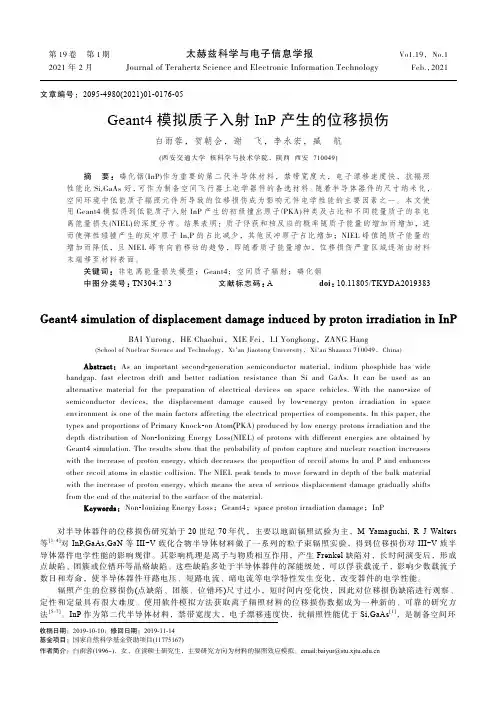
第19卷 第1期 太赫兹科学与电子信息学报Vo1.19,No.1 2021年2月 Journal of Terahertz Science and Electronic Information Technology Feb.,2021 文章编号:2095-4980(2021)01-0176-05Geant4模拟质子入射InP产生的位移损伤白雨蓉,贺朝会,谢 飞,李永宏,臧 航(西安交通大学核科学与技术学院,陕西西安 710049)摘 要:磷化铟(InP)作为重要的第二代半导体材料,禁带宽度大,电子漂移速度快,抗辐照性能比Si,GaAs好,可作为制备空间飞行器上电学器件的备选材料。
随着半导体器件的尺寸纳米化,空间环境中低能质子辐照元件所导致的位移损伤成为影响元件电学性能的主要因素之一。
本文使用Geant4模拟得到低能质子入射InP产生的初级撞出原子(PKA)种类及占比和不同能量质子的非电离能量损失(NIEL)的深度分布。
结果表明:质子俘获和核反应的概率随质子能量的增加而增加,进而使弹性碰撞产生的反冲原子In,P的占比减少,其他反冲原子占比增加;NIEL峰值随质子能量的增加而降低,且NIEL峰有向前移动的趋势,即随着质子能量增加,位移损伤严重区域逐渐由材料末端移至材料表面。
关键词:非电离能量损失模型;Geant4;空间质子辐射;磷化铟中图分类号:TN304.2+3文献标志码:A doi:10.11805/TKYDA2019383Geant4 simulation of displacement damage induced by proton irradiation in InPBAI Yurong,HE Chaohui,XIE Fei,LI Yonghong,ZANG Hang(School of Nuclear Science and Technology,Xi’an Jiaotong University,Xi’an Shaanxi 710049,China)Abstract:As an important second-generation semiconductor material, indium phosphide has wide bandgap, fast electron drift and better radiation resistance than Si and GaAs. It can be used as analternative material for the preparation of electrical devices on space vehicles. With the nano-size ofsemiconductor devices, the displacement damage caused by low-energy proton irradiation in spaceenvironment is one of the main factors affecting the electrical properties of components. In this paper, thetypes and proportions of Primary Knock-on Atom(PKA) produced by low energy protons irradiation and thedepth distribution of Non-Ionizing Energy Loss(NIEL) of protons with different energies are obtained byGeant4 simulation. The results show that the probability of proton capture and nuclear reaction increaseswith the increase of proton energy, which decreases the proportion of recoil atoms In and P and enhancesother recoil atoms in elastic collision. The NIEL peak tends to move forward in depth of the bulk materialwith the increase of proton energy, which means the area of serious displacement damage gradually shiftsfrom the end of the material to the surface of the material.Keywords:Non-Ionizing Energy Loss;Geant4;space proton irradiation damage;InP对半导体器件的位移损伤研究始于20世纪70年代,主要以地面辐照试验为主,M Yamaguchi, R J Walters 等[1-4]对InP,GaAs,GaN等III-V族化合物半导体材料做了一系列的粒子束辐照实验,得到位移损伤对III-V族半导体器件电学性能的影响规律。
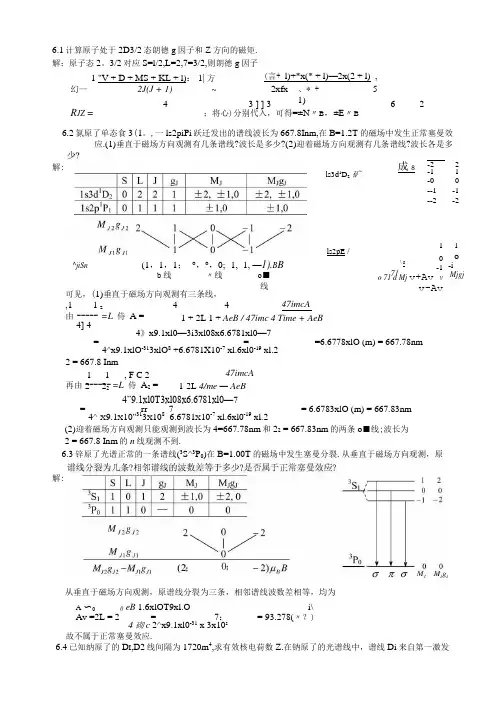
6.1计算原子处于2D3/2态朗德g 因子和Z 方向的磁矩. 解:原子态2。
3/2对应S=l/2,L=2,7=3/2,则朗德g 因子(言+ l)+*x(* + l)—2x(2 + l)_, 5 1 "V + D + MS + KL + l): 1| 方幻—2J(J + 1) ~ 2xfx 4 3 ] ] 3 6 2R JZ =;将心)分别代入,可得=±N 〃B ,±E 〃B 、* +1) 解: ls3d 1D 2 矿 ^jiSn (1,1,1; °,°,0; -1, -1, —1).B B o ■线 b 线 〃线 6.2氮原了单态食3(1。
,一ls2piPi 跃迁发出的谱线波长为667.8Inm,在B=1.2T 的磁场中发生正常塞曼效应.(1)垂直于磁场方向观测有几条谱线?波长是多少?(2)迎着磁场方向观测有几条谱线?波长各是多 -2 2 -1 1 -0 0--1 -1 --2 -2 成8 ls2pE / 可见,(1)垂直于磁场方向观测有三条线, ,1 1 z - 4 4由 ----- =L 侍 A =4] 4 1 0 -1 o 71 a Mj v+Av v v-Av \ r71 1o -iMjgj47imcA 1 + 2L 1 + AeB / 47imc 4 Time + AeB4》x9.1xl0—3i3xl08x6.6781xl0—7= ------------------ ------- ------------------- = ------------ - ------ =6.6778xlO (m) = 667.78nm 4^x9.1xlO -313xlO 8 +6.6781X10-7 xl.6xl0-19 xl.2 2 = 667.8 Inm1 1 , F C 2再由 ------ =L 侍 A 2 = ------------ 47imcA 2 22 1-2L4/me — AeB 4”9.1xl0T3xl08x6.6781xl0—7= ------------------ rr------- 7 ------------------- -------------- ------- = 6.6783xlO (m) = 667.83nm 4^-X 9.1X 10"313X 108 -6.6781X 10-7 xl.6xl0-19 xl.2(2)迎着磁场方向观测只能观测到波长为4=667.78nm 和22 = 667.83nm 的两条o ■线;波长为 2 = 667.8 Inm 的n 线观测不到.6.3锌原了光谱正常的一条谱线(3S^3P 0)在B=1.00T 的磁场中发生塞曼分裂.从垂直于磁场方向观测,原解:从垂直于磁场方向观测,原谱线分裂为三条,相邻谱线波数差相等,均为 A 〜0 0 eB 1.6xlOT9xl.O_i\ Av =2L = 2 ---------- = ------------------- 7: ------- = 93.278(〃?) 4 砌c 2^x9.1xl0-31 x 3x10s故不属于正常塞曼效应.6.4已知纳原了的D I ,D2线间隔为1720m 4,求有效核电荷数Z.在钠原了的光谱线中,谱线Di 来自第一激发态32p”到基态32S 1P 的跃迁,其波长为589.6nm,当钠原了放在磁场B 中时,D 】线将分裂为四条谱线, 设磁场强度B=0.2T,求四重线中最短与最长的两条谱线之间的波长差. 四重线中最短与最长的两条谱线之间的波长差由:—4 min1“maxZH A2 8 r 得: ------- =~L2.2 3min maxBiJ:A2 = -L22 =-—L6M :x0.2_ x5 8962 xl0-i4 = 8 6469x1012(/«) = 8.6469x 10" A 3 3 47x9.1x10 31x3x1086.5基态钠原子处在磁场为B 的微波谐振腔中,频率为v = 1.0xl()i°Hz 的电磁波经波导输入谐振腔,磁场多强时,电磁波能量会被强烈吸收?解:基态钠原子符号 3S 2S I /2 :S=1 /2,L=0,J= 1 /2,gj=2,Mj= +1/2.两子能级间隔:AE = g J /H B B 当电磁波能量被强烈吸收时,有hv = gj/J B Bn hv 6.63xlO-34xl.OxlO 10 l.OxlO 10 x4^x9.1xlQ-31B = ------- = ---------- 话 --------- 新 ---- = ----------------- 商 ----- =0.357356 TW B 2x1.6x1-19x6.63x10-34/4如 2xl.6xT 196.6在核磁共振谱仪中,当共振频率调谐到42.57MHz 时观测到含氢样品的共振吸收,求所加磁场的大小. 当调谐到16.55MHz 时,观测到’Li 样品的共振吸收,已知g H = 5.585,1- = 3/2,计算7Li 的g 因了和 磁矩值. 解:由 hv == g ;jU N B 得,hv hv…,… ,… A TI M V 4勿 X 1.67X 10 27X 4.257X 107 , NB = ____ — _________ — ______ — ________________________ = ] .0 (T)g —N g[he/4沛1 egj 1.6xr 19 x5.585对 ’Li 油 hv = g lLi M N B_ hv _ hv _ 4*“ _ 4〃x 1.67xl(T27 xl.655xl (r _ 2 ]7 S ,u ~ ~ Bhe / 4 兀M ~ eB ~ 1.6xF 19xl.O —' = S I J^N = 2.17X *〃N = 3.255〃N6.7试证明原子在6G3/2态的磁矩为0,用矢量模型说明之。
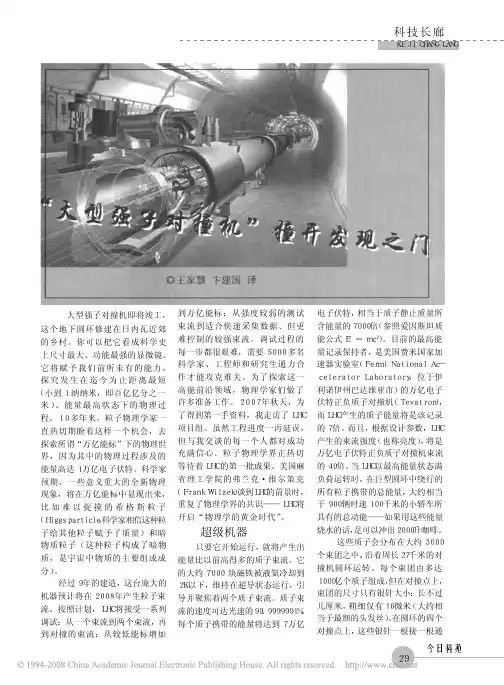
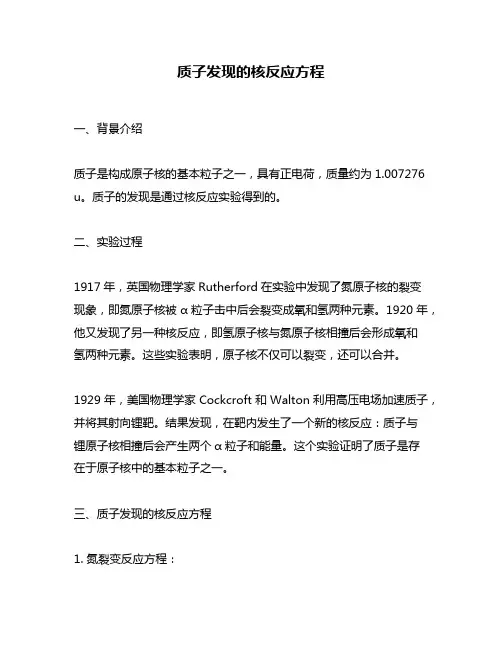
质子发现的核反应方程
一、背景介绍
质子是构成原子核的基本粒子之一,具有正电荷,质量约为1.007276 u。
质子的发现是通过核反应实验得到的。
二、实验过程
1917年,英国物理学家Rutherford在实验中发现了氮原子核的裂变
现象,即氮原子核被α粒子击中后会裂变成氧和氢两种元素。
1920年,他又发现了另一种核反应,即氢原子核与氮原子核相撞后会形成氧和
氢两种元素。
这些实验表明,原子核不仅可以裂变,还可以合并。
1929年,美国物理学家Cockcroft和Walton利用高压电场加速质子,并将其射向锂靶。
结果发现,在靶内发生了一个新的核反应:质子与
锂原子核相撞后会产生两个α粒子和能量。
这个实验证明了质子是存
在于原子核中的基本粒子之一。
三、质子发现的核反应方程
1. 氮裂变反应方程:
14N + α → 17O + p
其中,“α”表示α粒子,“p”表示质子。
2. 氢与氮合并反应方程:
1H + 14N → 15O + γ
其中,“γ”表示光子。
3. 质子与锂合并反应方程:
1H + 7Li → 2α + 17.3 MeV
其中,“MeV”表示兆电子伏特。
四、质子发现的意义
质子的发现为核物理学的发展奠定了基础,同时也为人类探索原子核结构和核能利用提供了重要的实验依据。
此外,质子还是医学上广泛应用的粒子之一,例如在放射治疗中,利用高能质子束可以精确地照射肿瘤组织,最大限度地减少对健康组织的损伤。
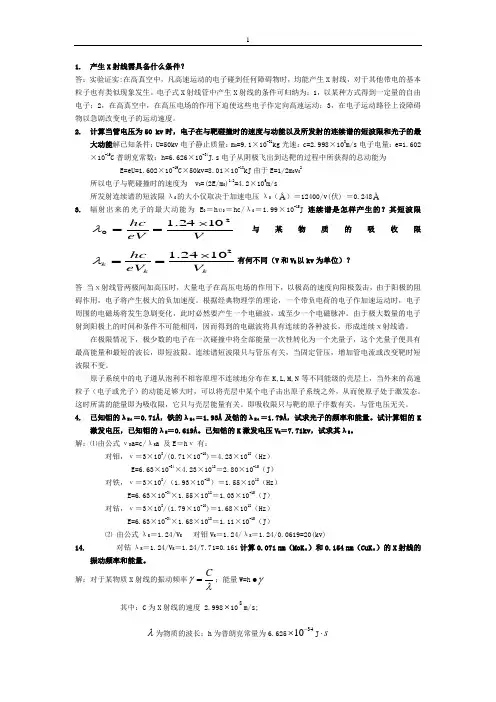
1. 产生X 射线需具备什么条件?答:实验证实:在高真空中,凡高速运动的电子碰到任何障碍物时,均能产生X 射线,对于其他带电的基本粒子也有类似现象发生。
电子式X 射线管中产生X 射线的条件可归纳为:1,以某种方式得到一定量的自由电子;2,在高真空中,在高压电场的作用下迫使这些电子作定向高速运动;3,在电子运动路径上设障碍物以急剧改变电子的运动速度。
2. 计算当管电压为50 kv 时,电子在与靶碰撞时的速度与动能以及所发射的连续谱的短波限和光子的最大动能解已知条件:U=50kv 电子静止质量:m 0=9.1×10-31kg 光速:c=2.998×108m/s 电子电量:e=1.602×10-19C 普朗克常数:h=6.626×10-34J.s 电子从阴极飞出到达靶的过程中所获得的总动能为 E=eU=1.602×10-19C ×50kv=8.01×10-18kJ 由于E=1/2m 0v 02 所以电子与靶碰撞时的速度为 v 0=(2E/m 0)1/2=4.2×106m/s所发射连续谱的短波限λ0的大小仅取决于加速电压λ0(Å)=12400/v(伏) =0.248Å3. 辐射出来的光子的最大动能为 E 0=h ʋ0=hc/λ0=1.99×10-15J 连续谱是怎样产生的?其短波限VeVhc 201024.1⨯==λ与某物质的吸收限kkk V eVhc 21024.1⨯==λ有何不同(V 和V K 以kv 为单位)?答 当ⅹ射线管两极间加高压时,大量电子在高压电场的作用下,以极高的速度向阳极轰击,由于阳极的阻碍作用,电子将产生极大的负加速度。
根据经典物理学的理论,一个带负电荷的电子作加速运动时,电子周围的电磁场将发生急剧变化,此时必然要产生一个电磁波,或至少一个电磁脉冲。
由于极大数量的电子射到阳极上的时间和条件不可能相同,因而得到的电磁波将具有连续的各种波长,形成连续ⅹ射线谱。
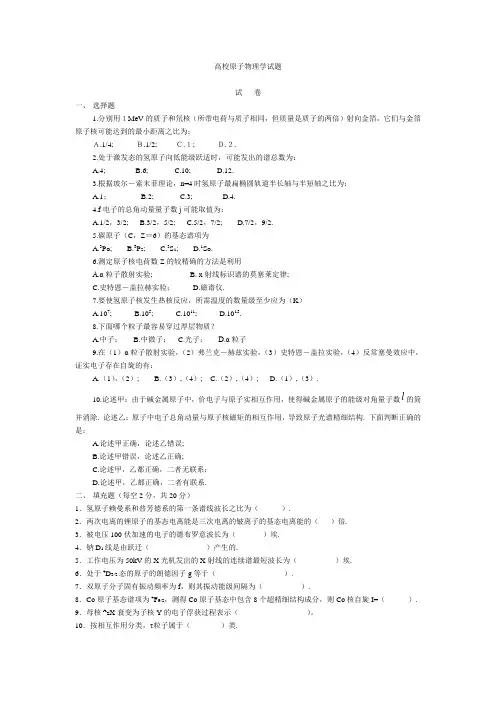
高校原子物理学试题试卷一、选择题1.分别用1MeV的质子和氘核(所带电荷与质子相同,但质量是质子的两倍)射向金箔,它们与金箔原子核可能达到的最小距离之比为:A.1/4;B.1/2; C.1; D.2.2.处于激发态的氢原子向低能级跃适时,可能发出的谱总数为:A.4;B.6;C.10;D.12.3.根据玻尔-索末菲理论,n=4时氢原子最扁椭圆轨道半长轴与半短轴之比为:A.1;B.2;C.3;D.4.4.f电子的总角动量量子数j可能取值为:A.1/2,3/2;B.3/2,5/2;C.5/2,7/2;D.7/2,9/2.5.碳原子(C,Z=6)的基态谱项为A.3P O;B.3P2;C.3S1;D.1S O.6.测定原子核电荷数Z的较精确的方法是利用A.α粒子散射实验;B. x射线标识谱的莫塞莱定律;C.史特恩-盖拉赫实验;D.磁谱仪.7.要使氢原子核发生热核反应,所需温度的数量级至少应为(K)A.107;B.105;C.1011;D.1015.8.下面哪个粒子最容易穿过厚层物质?A.中子;B.中微子;C.光子;D.α粒子9.在(1)α粒子散射实验,(2)弗兰克-赫兹实验,(3)史特恩-盖拉实验,(4)反常塞曼效应中,证实电子存在自旋的有:A.(1),(2);B.(3),(4);C.(2),(4);D.(1),(3).l的简10.论述甲:由于碱金属原子中,价电子与原子实相互作用,使得碱金属原子的能级对角量子数并消除. 论述乙:原子中电子总角动量与原子核磁矩的相互作用,导致原子光谱精细结构. 下面判断正确的是:A.论述甲正确,论述乙错误;B.论述甲错误,论述乙正确;C.论述甲,乙都正确,二者无联系;D.论述甲,乙都正确,二者有联系.二、填充题(每空2分,共20分)1.氢原子赖曼系和普芳德系的第一条谱线波长之比为().2.两次电离的锂原子的基态电离能是三次电离的铍离子的基态电离能的()倍.3.被电压100伏加速的电子的德布罗意波长为()埃.4.钠D1线是由跃迁()产生的.5.工作电压为50kV的X光机发出的X射线的连续谱最短波长为()埃.6.处于4D3/2态的原子的朗德因子g等于().7.双原子分子固有振动频率为f,则其振动能级间隔为().8.Co原子基态谱项为4F9/2,测得Co原子基态中包含8个超精细结构成分,则Co核自旋I=(). 9.母核A Z X衰变为子核Y的电子俘获过程表示()。
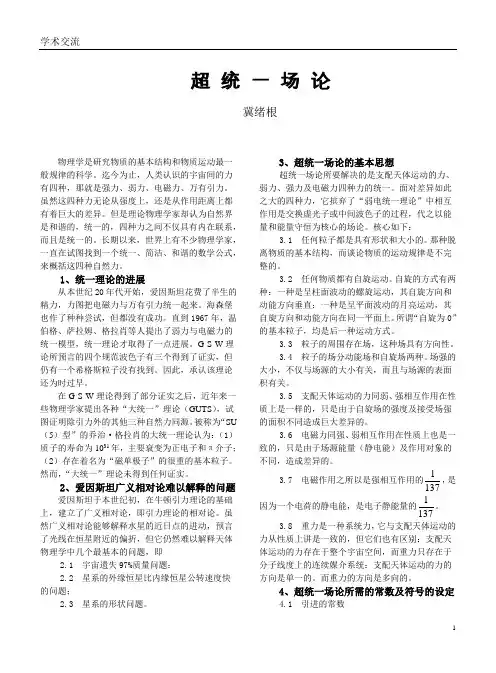
物理学是研究物质的基本结构和物质运动最一般规律的科学。
迄今为止,人类认识的宇宙间的力有四种,那就是强力、弱力、电磁力、万有引力。
虽然这四种力无论从强度上,还是从作用距离上都有着巨大的差异。
但是理论物理学家却认为自然界是和谐的,统一的,四种力之间不仅具有内在联系,而且是统一的。
长期以来,世界上有不少物理学家,一直在试图找到一个统一、简洁、和谐的数学公式,来概括这四种自然力。
1、统一理论的进展从本世纪20年代开始,爱因斯坦花费了半生的精力,力图把电磁力与万有引力统一起来。
海森堡也作了种种尝试,但都没有成功。
直到1967年,温伯格、萨拉姆、格拉肖等人提出了弱力与电磁力的统一模型,统一理论才取得了一点进展。
G·S·W理论所预言的四个规范波色子有三个得到了证实,但仍有一个希格斯粒子没有找到。
因此,承认该理论还为时过早。
在G·S·W理论得到了部分证实之后,近年来一些物理学家提出各种“大统一”理论(GUTS),试图证明除引力外的其他三种自然力同源。
被称为“SU (5)型”的乔治·格拉肖的大统一理论认为:(1)质子的寿命为1031年,主要衰变为正电子和π介子;(2)存在着名为“磁单极子”的很重的基本粒子。
然而,“大统一”理论未得到任何证实。
2、爱因斯坦广义相对论难以解释的问题爱因斯坦于本世纪初,在牛顿引力理论的基础上,建立了广义相对论,即引力理论的相对论。
虽然广义相对论能够解释水星的近日点的进动,预言了光线在恒星附近的偏折,但它仍然难以解释天体物理学中几个最基本的问题,即2.1 宇宙遗失97%质量问题;2.2 星系的外缘恒星比内缘恒星公转速度快的问题;2.3 星系的形状问题。
3、超统一场论的基本思想超统一场论所要解决的是支配天体运动的力、弱力、强力及电磁力四种力的统一。
面对差异如此之大的四种力,它摈弃了“弱电统一理论”中相互作用是交换虚光子或中间波色子的过程,代之以能量和能量守恒为核心的场论。

核弹原理公式核弹是一种破坏力极大的武器,它的原理是利用核反应产生的巨大能量来引发爆炸。
核反应是指原子核的裂变或聚变过程,在这个过程中释放出巨大的能量。
核弹的设计和制造涉及复杂的物理和工程原理。
核反应的原理可以用以下公式来表示:E=mc^2其中,E表示能量,m表示物质的质量,c表示光速。
这是爱因斯坦的质能方程,意味着质量和能量之间存在等价关系。
核弹的工作原理有两种:核裂变和核聚变。
核裂变是指重核(如铀、钚等)被中子撞击后分裂成两个或更多的轻核的过程。
在这个过程中,大量的能量被释放出来。
核裂变的公式可以表示为:235U + n -> 92Kr + 141Ba + 3n + Q其中,235U表示铀-235,n表示中子,92Kr和141Ba是分裂产物,3n表示释放出的中子,Q表示裂变释放的能量。
核聚变是指轻核(如氢、氦等)在极高温度和压力下融合成更重的核的过程。
核聚变也会释放出巨大的能量。
核聚变的公式可以表示为:2H + 3H -> 4He + n + Q其中,2H表示氘,3H表示氚,4He表示氦-4,n表示中子,Q表示聚变释放的能量。
核弹的设计需要控制裂变或聚变过程的速度和规模,以及合理地引爆和放大能量释放的过程。
这需要精确的物理和工程计算,以确保核弹的爆炸能够达到预期的破坏力。
除了核反应产生的能量,核弹的爆炸还涉及到爆炸物的化学反应和工程结构的设计。
爆炸物的化学反应可以提供更多的能量释放,而工程结构的设计可以控制爆炸的冲击波和辐射的扩散。
总之,核弹的原理是基于核反应产生的巨大能量,通过控制裂变或聚变过程来引发爆炸。
核弹的设计和制造依赖于复杂的物理和工程原理,以及精确的计算和设计。
核弹作为一种极具破坏力的武器,应该受到国际社会的高度关注和限制。
arXiv:hep-ex/9502003v1 6 Feb 1995JetproductioninhighQ2deep-inelasticepscatteringatHERA
ZEUSCollaboration
AbstractTwo-jetproductionindeep-inelasticelectron-protonscatteringhasbeenstudiedfor160HERA.Thekinematicpropertiesofthejetsandthejetproductionratesarepresented.Thepartonicscalingvariablesofthetwo-jetsystemandtherateoftwo-jetproductionarecomparedtoperturbativenext-to-leadingorderQCDcalculations.TheZEUSCollaborationM.Derrick,D.Krakauer,S.Magill,D.Mikunas,B.Musgrave,J.Repond,R.Stanek,R.L.Talaga,H.ZhangArgonneNationalLaboratory,Argonne,IL,USAp
R.Ayad1,G.Bari,M.Basile,L.Bellagamba,D.Boscherini,A.Bruni,G.Bruni,P.Bruni,G.CaraRomeo,G.Castellini2,M.Chiarini,L.Cifarelli3,F.Cindolo,A.Contin,I.Gialas,P.Giusti,G.Iacobucci,G.Laurenti,G.Levi,A.Margotti,T.Massam,R.Nania,C.Nemoz,F.Palmonari,A.Polini,G.Sartorelli,R.Timellini,Y.ZamoraGarcia1,A.ZichichiUniversityandINFNBologna,Bologna,Italyf
A.Bargende,J.Crittenden,K.Desch,B.Diekmann4,T.Doeker,M.Eckert,L.Feld,A.Frey,M.Geerts,G.Geitz5,M.Grothe,T.Haas,H.Hartmann,D.Haun4,K.Heinloth,E.Hilger,H.-P.Jakob,U.F.Katz,S.M.Mari,A.Mass,S.Mengel,J.Mollen,E.Paul,Ch.Rembser,R.Schattevoy6,D.Schramm,J.Stamm,R.WedemeyerPhysikalischesInstitutderUniversit¨atBonn,Bonn,FederalRepublicofGermanyc
S.Campbell-Robson,A.Cassidy,N.Dyce,B.Foster,S.George,R.Gilmore,G.P.Heath,H.F.Heath,T.J.Llewellyn,C.J.S.Morgado,D.J.P.Norman,J.A.O’Mara,R.J.Tapper,S.S.Wilson,R.YoshidaH.H.WillsPhysicsLaboratory,UniversityofBristol,Bristol,U.K.o
R.R.RauBrookhavenNationalLaboratory,Upton,L.I.,USAp
M.Arneodo7,L.Iannotti,M.Schioppa,G.SusinnoCalabriaUniversity,PhysicsDept.andINFN,Cosenza,Italyf
A.Bernstein,A.Caldwell,J.A.Parsons,S.Ritz,F.Sciulli,P.B.Straub,L.Wai,S.Yang,Q.ZhuColumbiaUniversity,NevisLabs.,IrvingtononHudson,N.Y.,USAq
P.Borzemski,J.Chwastowski,A.Eskreys,K.Piotrzkowski,M.Zachara,L.ZawiejskiInst.ofNuclearPhysics,Cracow,Polandj
L.Adamczyk,B.Bednarek,K.Eskreys,K.Jele´n,D.Kisielewska,T.Kowalski,E.Rulikowska-Zar¸ebska,L.Suszycki,J.Zaj¸acFacultyofPhysicsandNuclearTechniques,AcademyofMiningandMetallurgy,Cracow,Polandj
A.Kota´nski,M.Przybycie´nJagellonianUniv.,Dept.ofPhysics,Cracow,Polandk
L.A.T.Bauerdick,U.Behrens,H.Beier8,J.K.Bienlein,C.Coldewey,O.Deppe,K.Desler,G.Drews,M.Flasi´nski9,D.J.Gilkinson,C.Glasman,P.G¨ottlicher,J.Große-Knetter,B.Gutjahr,W.Hain,D.Hasell,H.Heßling,H.Hultschig,Y.Iga,P.Joos,M.Kasemann,R.Klanner,W.Koch,L.K¨opke10,U.K¨otz,H.Kowal-ski,J.Labs,A.Ladage,B.L¨ohr,M.L¨owe,D.L¨uke,O.Ma´nczak,J.S.T.Ng,S.Nickel,D.Notz,K.Ohrenberg,M.Roco,M.Rohde,J.Rold´an,U.Schneekloth,W.Schulz,F.Selonke,E.Stiliaris11,B.Surrow,T.Voß,D.Westphal,G.Wolf,C.Youngman,J.F.ZhouDeutschesElektronen-SynchrotronDESY,Hamburg,FederalRepublicofGermany
H.J.Grabosch,A.Kharchilava,A.Leich,M.Mattingly,A.Meyer,S.SchlenstedtDESY-Zeuthen,Inst.f¨urHochenergiephysik,Zeuthen,FederalRepublicofGermany
G.Barbagli,P.PelferUniversityandINFN,Florence,Italyf
G.Anzivino,G.Maccarrone,S.DePasquale,L.VotanoINFN,LaboratoriNazionalidiFrascati,Frascati,Italyf
A.Bamberger,S.Eisenhardt,A.Freidhof,S.S¨oldner-Rembold12,J.Schroeder13,T.TrefzgerFakult¨atf¨urPhysikderUniversit¨atFreiburgi.Br.,Freiburgi.Br.,FederalRepublicofGermanyc
IN.H.Brook,P.J.Bussey,A.T.Doyle14,I.Fleck,V.A.Jamieson,D.H.Saxon,M.L.Utley,A.S.WilsonDept.ofPhysicsandAstronomy,UniversityofGlasgow,Glasgow,U.K.o
A.Dannemann,U.Holm,D.Horstmann,T.Neumann,R.Sinkus,K.WickHamburgUniversity,I.InstituteofExp.Physics,Hamburg,FederalRepublicofGermanyc
E.Badura15,B.D.Burow16,L.Hagge,E.Lohrmann,J.Mainusch,J.Milewski,M.Nakahata17,N.Pavel,G.Poelz,W.Schott,F.ZetscheHamburgUniversity,II.InstituteofExp.Physics,Hamburg,FederalRepublicofGermanyc
T.C.Bacon,I.Butterworth,E.Gallo,V.L.Harris,B.Y.H.Hung,K.R.Long,D.B.Miller,P.P.O.Morawitz,A.Prinias,J.K.Sedgbeer,A.F.WhitfieldImperialCollegeLondon,HighEnergyNuclearPhysicsGroup,London,U.K.o
U.Mallik,E.McCliment,M.Z.Wang,S.M.Wang,J.T.Wu,Y.ZhangUniversityofIowa,PhysicsandAstronomyDept.,IowaCity,USAp
P.Cloth,D.FilgesForschungszentrumJ¨ulich,Institutf¨urKernphysik,J¨ulich,FederalRepublicofGermany
S.H.An,S.M.Hong,S.W.Nam,S.K.Park,M.H.Suh,S.H.YonKoreaUniversity,Seoul,Koreah
R.Imlay,S.Kartik,H.-J.Kim,R.R.McNeil,W.Metcalf,V.K.NadendlaLouisianaStateUniversity,Dept.ofPhysicsandAstronomy,BatonRouge,LA,USAp
F.Barreiro18,G.Cases,R.Graciani,J.M.Hern´andez,L.Herv´as18,L.Labarga18,J.delPeso,J.Puga,J.Terron,J.F.deTroc´onizUniver.Aut´onomaMadrid,DeptodeF´ısicaTe´or´ıca,Madrid,Spainn
G.R.SmithUniversityofManitoba,Dept.ofPhysics,Winnipeg,Manitoba,Canadaa